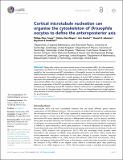Cortical microtubule nucleation can organise the cytoskeleton of Drosophila oocytes to define the anteroposterior axis
Author(s)
Khuc Trong, Philipp; Dunkel, Joern; Doerflinger, Helene; St. Johnston, Daniel; Goldstein, Raymond E.
DownloadTrong-2015-Cortical microtubule.pdf (5.721Mb)
PUBLISHER_CC
Publisher with Creative Commons License
Creative Commons Attribution
Terms of use
Metadata
Show full item recordAbstract
Many cells contain non-centrosomal arrays of microtubules (MTs), but the assembly, organisation and function of these arrays are poorly understood. We present the first theoretical model for the non-centrosomal MT cytoskeleton in Drosophila oocytes, in which bicoid and oskar mRNAs become localised to establish the anterior-posterior body axis. Constrained by experimental measurements, the model shows that a simple gradient of cortical MT nucleation is sufficient to reproduce the observed MT distribution, cytoplasmic flow patterns and localisation of oskar and naive bicoid mRNAs. Our simulations exclude a major role for cytoplasmic flows in localisation and reveal an organisation of the MT cytoskeleton that is more ordered than previously thought. Furthermore, modulating cortical MT nucleation induces a bifurcation in cytoskeletal organisation that accounts for the phenotypes of polarity mutants. Thus, our three-dimensional model explains many features of the MT network and highlights the importance of differential cortical MT nucleation for axis formation.
Date issued
2015-09Department
Massachusetts Institute of Technology. Department of MathematicsJournal
eLife
Publisher
eLife Sciences Publications, Ltd.
Citation
Khuc Trong, Philipp, Helene Doerflinger, Jorn Dunkel, Daniel St Johnston, and Raymond E Goldstein. “Cortical Microtubule Nucleation Can Organise the Cytoskeleton of Drosophila Oocytes to Define the Anteroposterior Axis.” eLife 4 (September 25, 2015).
Version: Final published version
ISSN
2050-084X